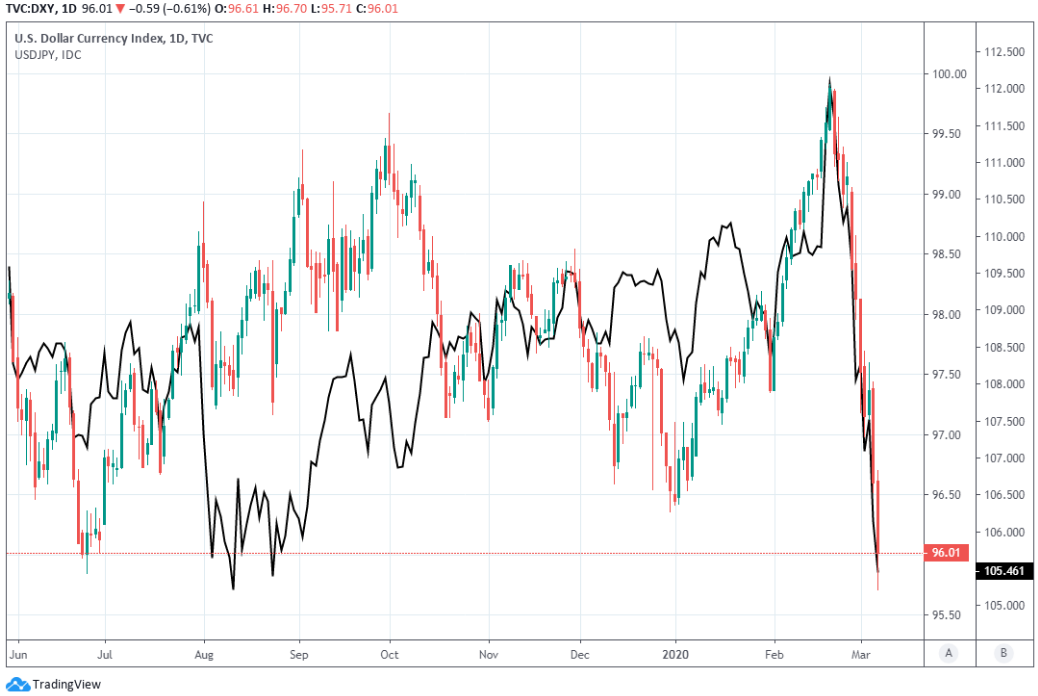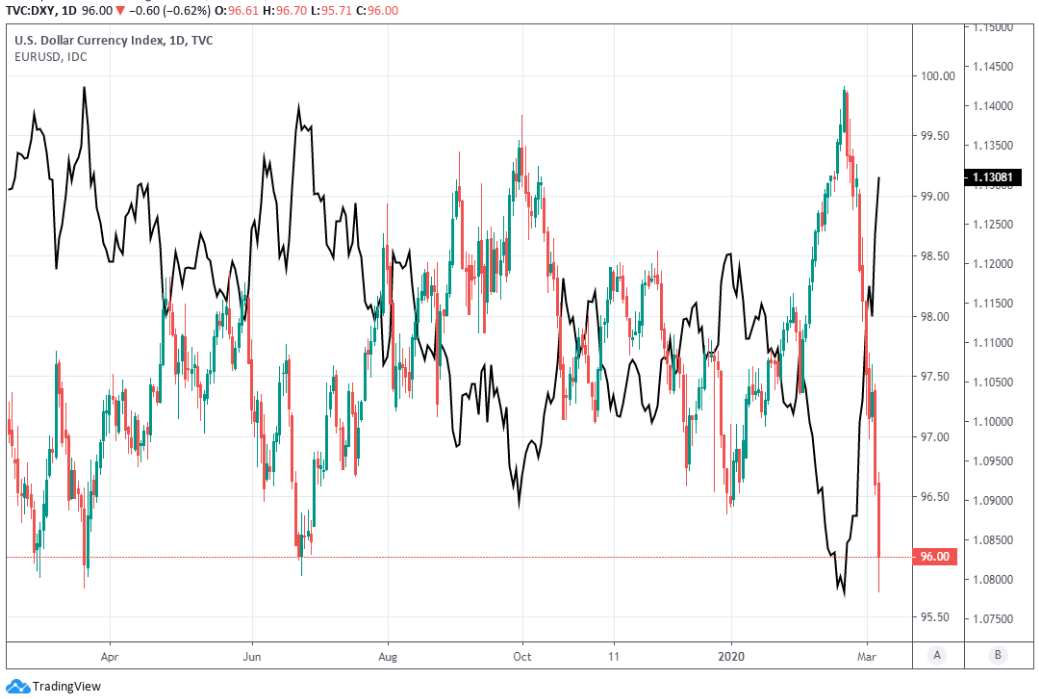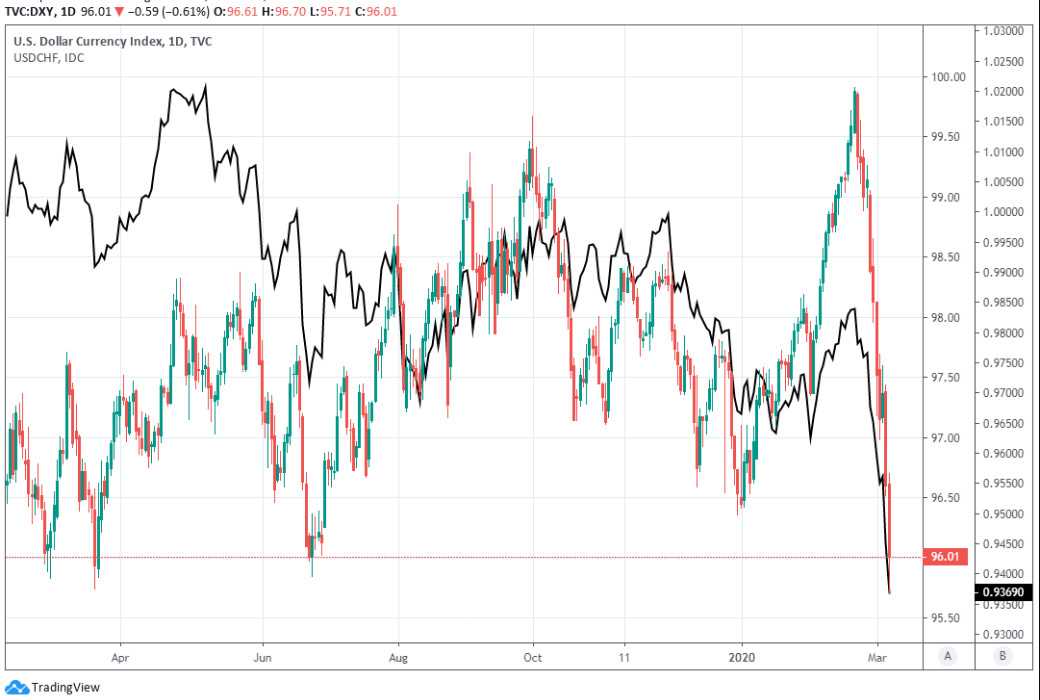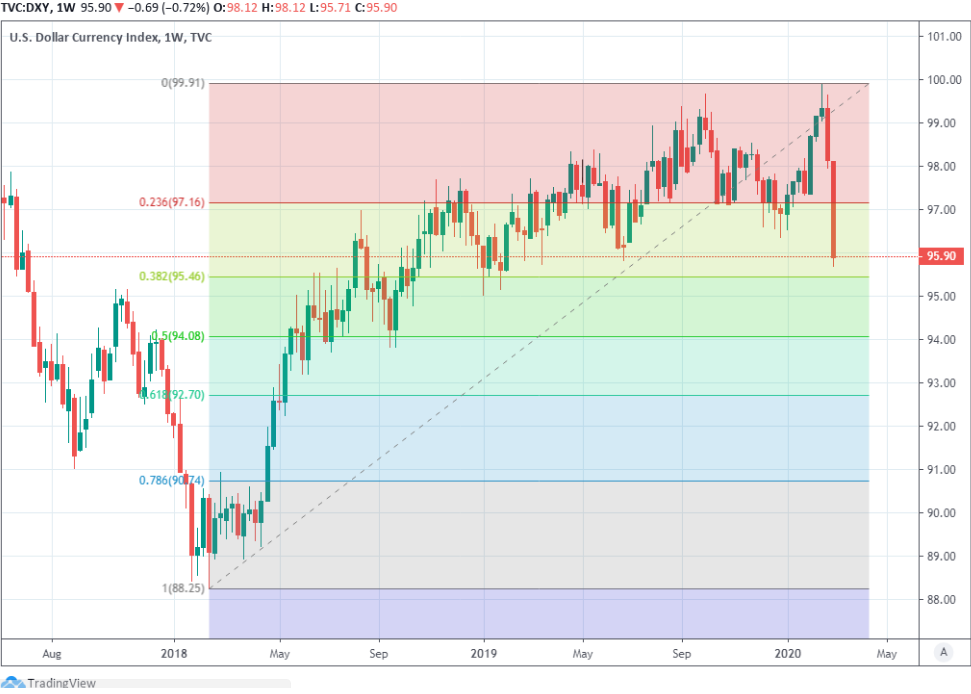Dollar Sits Like a Duck Even after Payrolls Surge, as Coronavirus Threatens Uptrend
- Written by: James Skinner
-
- USD overlooks Feb payrolls surge as coronavirus concerns mount.
- Global risk sell-off lifts JPY, EUR, CHF and weighs on USD index.
- After USD rate advantage cut by Fed and as local virus count rises.
- Markets pricing return toward 0% for Fed Funds rate. possible QE.
- Safe-haven outperformance to continue as virus grips global economy.
- Global economic fallout, Fed rate cuts to continue weighing on USD.

Image © Adobe Images
- GBP/USD Spot rate: 1.3024, up +0.56% today
- Indicative bank rates for transfers: 1.2668-1.2759
- Transfer specialist indicative rates: 1.2829-1.2907 >> Get your quote now
The Dollar overlooked a non-farm payrolls surge and sank to new multi-month lows against the Euro and Yen Friday as the Dollar Index headed for its worst intraday performance in more than two years amid another global market meltdown induced by fears of what coronavirus might do to the global economy.
The Dollar was down against all major rivals other than the equally battered and bruised Canadian Loonie Friday and not even a significant non-farm payrolls surge for the month of February was able to lift the now-sitting-duck Dollar from the mire it's been in ever since the Federal Reserve (Fed) cut the cash rate by 50 basis points to 1.25% Tuesday.
"While these figures suggest that consumer fundamentals are solid heading into the covid-19 outbreak, the deterioration in consumer confidence is likely to translate into a deterioration in household spending, and the expected rise in the unemployment rate over the quarters ahead should be enough to see the Fed continue to cut rates," says Katherine Judge at CIBC Capital Markets.
U.S. non-farm payrolls rose by a standout 273k in February when they had been expected to rise just 175k and January's number was also revised up, from 225k to 273k. Wage growth ticked higher to 0.3% and the unemployment rate fell back to a multi-decade low of 3.5% in another demonstration of exactly the economic outperformance that had lifted the Dollar so strongly in the last year, but which is now moot for the greenback.

Above: Dollar Index shown at daily intervals alongside USD/JPY rate.
The Fed slashed its cash rate to 1.25% this week, obliterating much of the Dollar’s yield advantage over other currencies in an effort to shore up confidence in the domestic and global economies after it became clear that many countries outside China now face potential epidemics of the coronavirus that brought the world's second largest economy to its knees this quarter.
"We have changed our baseline scenario for this year’s outlook and expect that the economic consequences of the spread of Covid19 will be longer lasting and more severe than we had assumed," says Karsten Junius at J. Safra Sarasin. "Rapid spreading of the virus beyond China makes a global pandemic more likely and measures to contain it will dampen economic activity in many areas. Tourism, air travel, restaurants, hotels and high street retail will be most affected by efforts to minimize interaction with possibly infected people."
China's government shut off entire cities from the rest of the country to contain the virus and citizens isolated themselves indoors in order to avoid infection, likely dealing the economy a near-fatal blow in the first quarte of the year although official data will not be released until well into April.
And with the coronavirus now spreading in the U.S including in California and New York, some investors may be contemplating the lengths Americans will go to in order to protect themselves. There were 233 confirmed cases of the disease in the U.S. as of Friday morning, with 14 deaths making for a mortality rate of 6% so far, although measuring and managing the spread of the infection has been hampered by a lack of testing equipment at the state level.

Above: Dollar Index shown at daily intervals alongside EUR/USD rate.
Friday's payrolls were released amid another market meltdown as investors dumped stocks and commodities ahead of a weekend that could bring further adverse headlines relating to outbreaks in the U.S., Europe and further afield, while stampeding into the perceived safety of the bond market where yields of some Treasuries including the U.S. 10-year fell to new record lows on Friday.
And that risk-aversion was lifting safe-haven currencies like the Japanese Yen, Swiss Franc and also increasingly it would appear, the Euro - which is a problem for the Dollar because the three rival currencies account for more than three quarters of flows measured by the Dollar Index.
"Continued pressure in global equities sees investors rotate into safe-haven assets, particularly in high-quality sovereign bonds, and price an aggressive policy response from central bankers with room to cut," says Chris Turner, global head of markets at ING.
The Dollar Index was down -1.13% Friday, leaving it on course for its largest one-day decline since January 16, 2018 and its worst week since May 2017, with the greenback ceding ground to each Dollar Index constituent except for the Canadian Dollar - the USD/CAD rate was up 0.28% at 1.3428. And with the Euro, Yen and Franc increasingly expected to go on outperforming, the Dollar Index appears to be on course for more losses ahead.

Above: Dollar Index shown at daily intervals alongside USD/CHF rate.
Furthermore, and as the coronavirus count rises in the U.S. and elsewhere, the risk of additional Federal Reserve rate cuts will grow if the increasing tally is accompanied by more pandemonium in markets for risk assets or if the infection leads to further clearly observable signs of economic damage.
And that would do even more damage to a Dollar that's been left looking like a sitting duck this week by the existing 50 basis point reduction in interest rate differentials with other currencies.
On Friday the Dollar Index had erased all of its earlier 2020 gains and committed itself to at least a partial retracement of its post-April 2018 uptrend. And what matters now is whether gains over smaller and riskier index constituents like Pound Sterling, the Canadian Dollar and Swedish Krona - which account for only 25% of the index - will be enough to offset losses to the likes of the Yen and Euro.
"The spread of Covid-19, its economic impact and the policy response remain highly uncertain, but it seems as though the FX markets are starting to price in the Fed’s money printing presses being properly fired up again. If the Fed were to restart QE, we would expect the dollar to undertake a much deeper decline than the one we currently pencil in (e.g. EUR/$ to 1.15 in 2Q20). This would really be the US monetary story converging on the zero rates and QE underway among major trading partners," Turner says. 
Above: Dollar Index shown at weekly intervals with Fibonacci retracements of April 2018 trend marked out.




